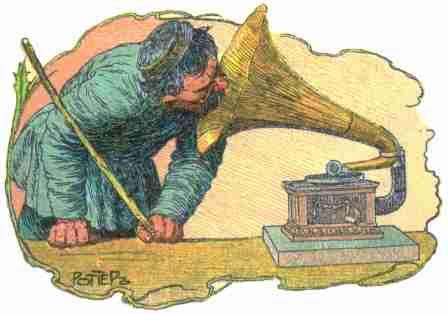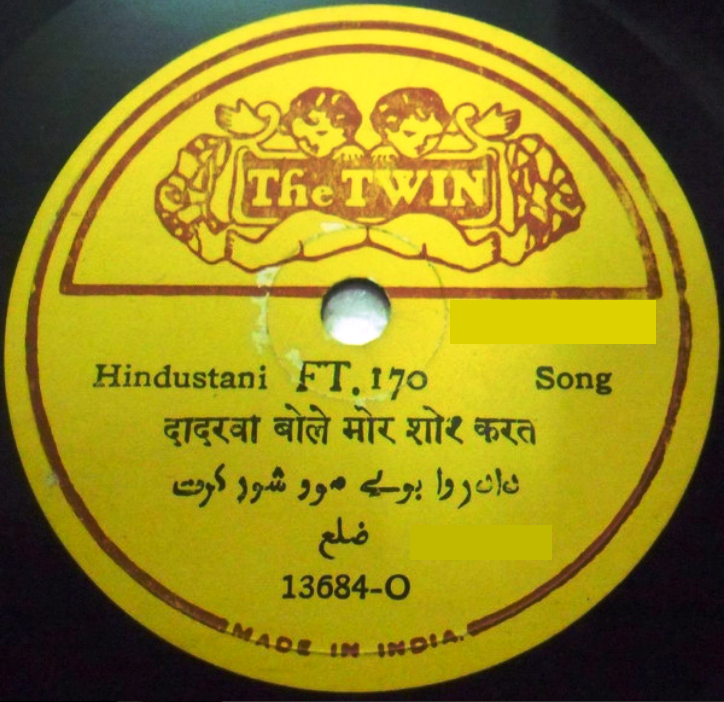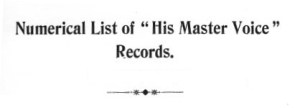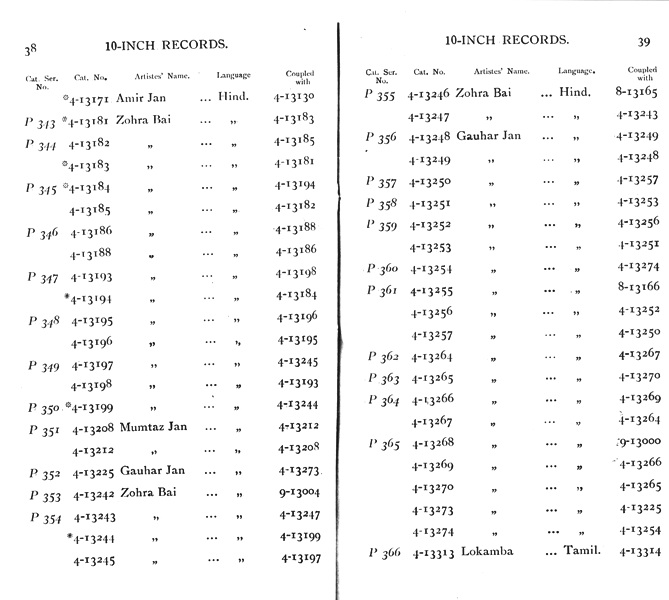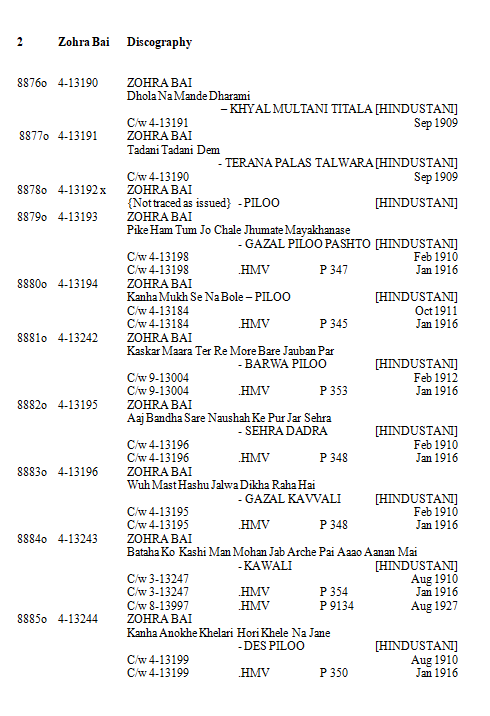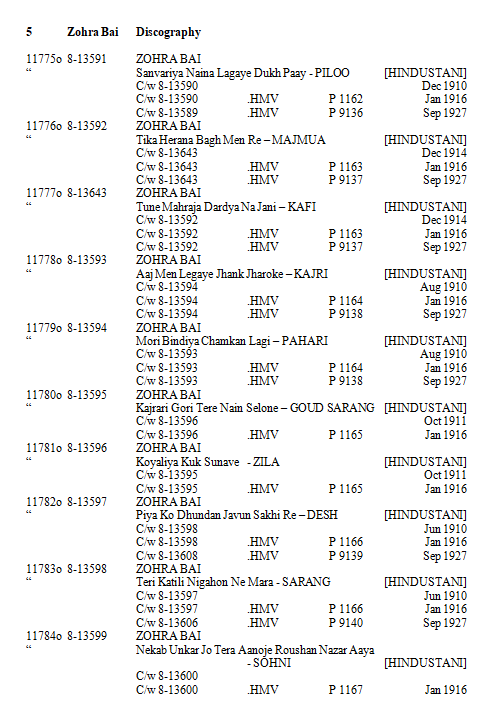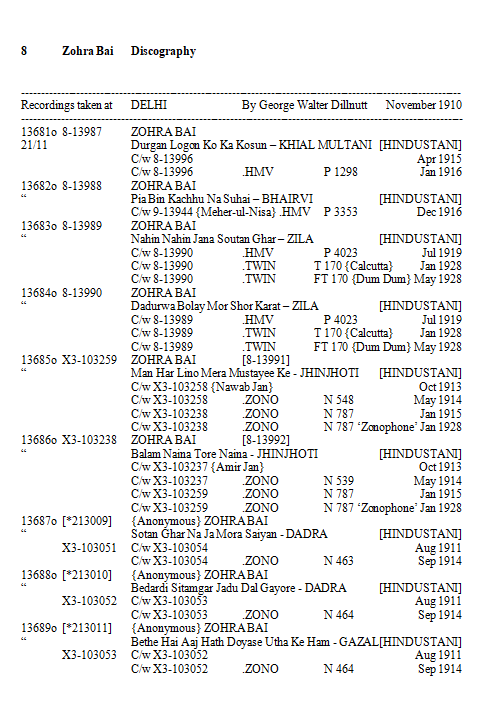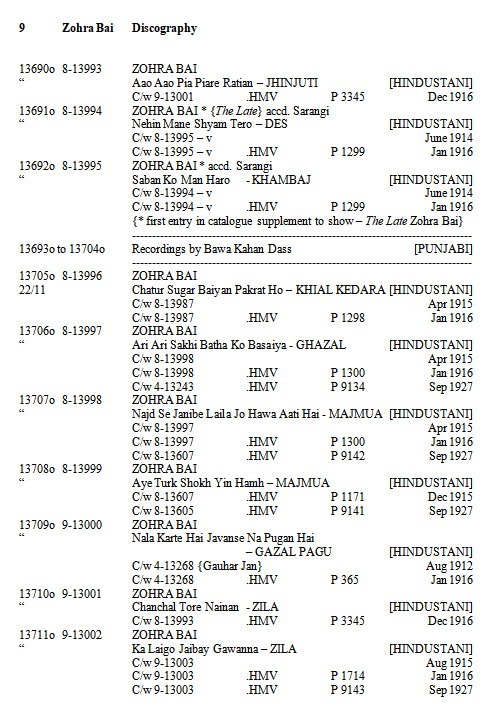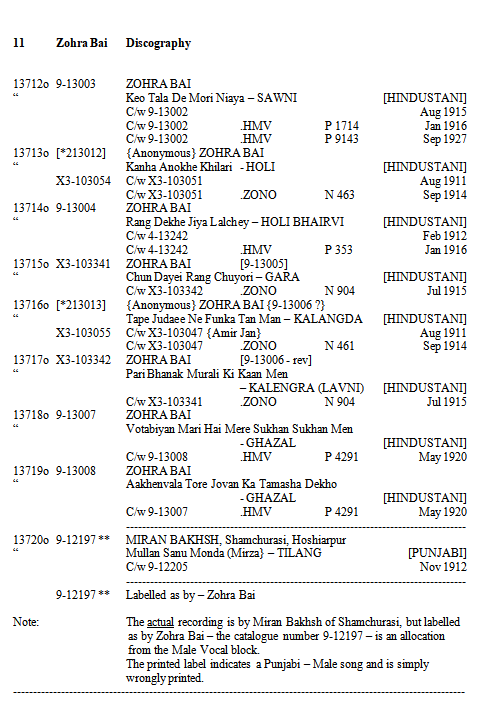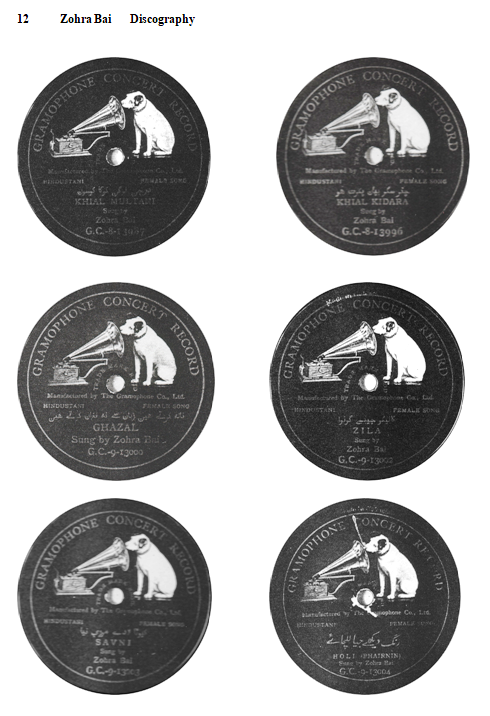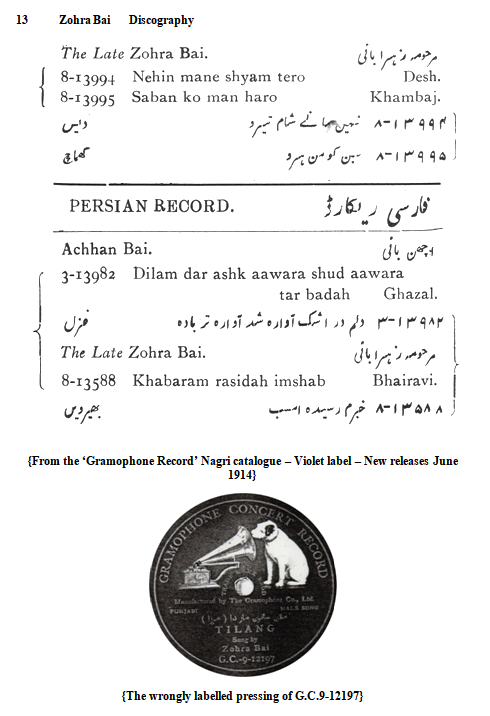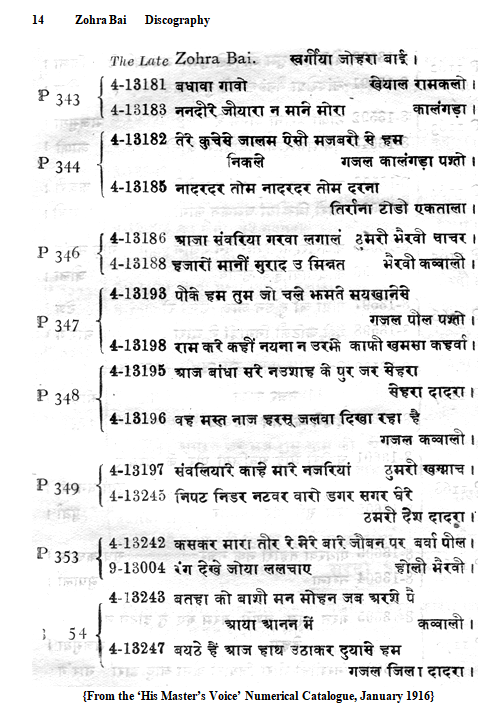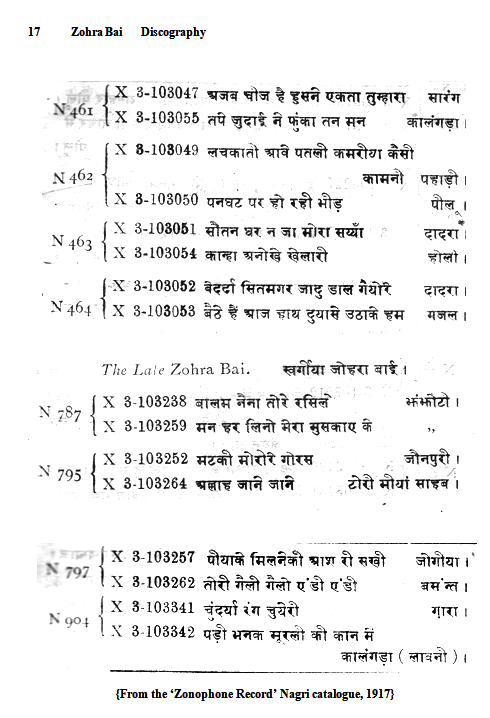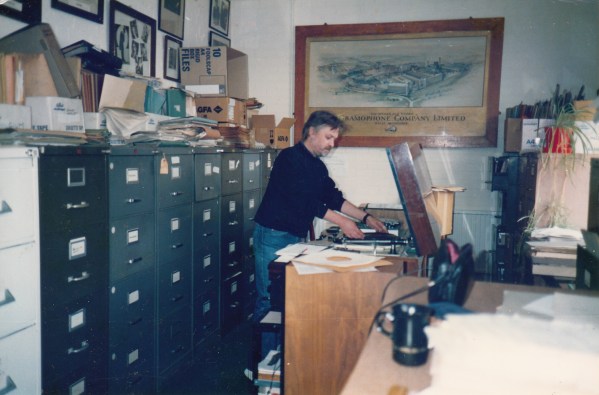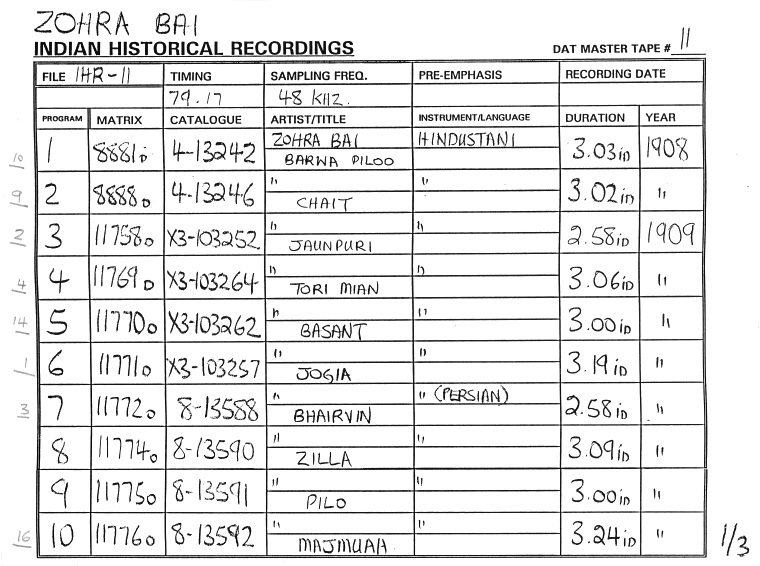ZOHRA BAI – AGRAWALE
ARTICLE and DISCOGRAPHY
by Michael Kinnear
ZOHRA BAI – AGRAWALE
Recordings for the ‘Gramophone’
Accredited as Zohra Bai: Photo Courtesy: Patrick Moutal Site – Indian Music
11789o 8-13604 ZOHRA BAI
Tarana – BHUPALI [HINDUSTANI]
13705o 8-13996 ZOHRA BAI
Chatur Sugar Baiyan Pakrat Ho – KHIAL KEDARA [HINDUSTANI]
Zohra Bai of Agra is often referred to as one of the greatest singers of India performing at the turn of the century. Very little is known of her life and most references about her musical prowess appear to be more anecdotal than fact. According to some reports she was born in Agra in 1868, and received her musical training from Ahmad Khan a vocalist and sarangi player also of Agra.
Ahmad Khan is reported to have learnt dhrupad and dhamar styles from Ghulam Abbas Khan (1825–1934?) one of the progenitors of the Agra Gharana. Ahmad Khan is also said to have learnt kheyal from Mehbub Khan Daras (1845-1922?) of Atrauli. It is also related that Ahmad Khan had a particular fondness for Zohra Bai, and had trained her her to maturity.
Some references claim that Zohra Bai received musical tuition from Kale Khan of Mathura, who was married to Qadri Begum, a daughter of Ghulam Abbas Khan, and who composed songs under the name of ‘Saras Piya’.
Other references describe Zohra Bai as a courtesan who had for some years in her adult life spent much time performing at ‘Jalsas’ in the Durbars of United Provinces, and is said to have been a fine dancer as well as an exceptional vocalist.
There may be elements of truth in all of these references, however, the a true account of Zohra Bai’s personal life remains open to speculation or debate, until further contributions or research come to light.
The focus of this article is to relate some information relating to Zohra Bai’s career as a recording artist, which, with the passage of time, appears to be the major source of knowledge about her musical abilities.
Although several sound recording companies were active in India during the early 1900’s, The Gramophone & Typewriter, Ltd., had emerged as the market leader, and by 1908 had built a factory at Sealdah, in central Calcutta, to provide for the public interest in ‘Gramophone’ records in India.
During 1906-07, The Gramophone & Typewriter, Ltd., had engaged in an extensive recording tour of India, led by William Conrad Gaisberg, which produced several hundred recordings in a number of dialects and musical styles. While some of these recordings were of musical merit, the general consensus of the record buying public was that the selections on offer was rather mediocre.
For the 1908-09 season, The Gramophone Company, Limited, heeded to local advice, and proceeded to ‘sign-up’ some higher class musicians, which were more appealing to the admirers of classical styles of either North or South Indian music.
Due to the heavy workload of recording in India two recording experts were required with George Walter Dillnutt commencing recording in February 1908 at Bombay, while Frederick William Gaisberg, was in charge of the recording sessions in Calcutta, which commenced in April 1908.
Frederick Gaisberg had been chosen to conduct the recording sessions in Calcutta, which featured some important artists that the company had recently placed under ‘exclusive’ contract, including Zohra Bai of Agra, Mumtaz Jan of Delhi, Bedana Dassi of Calcutta, Miss Achhan of Bombay, Nawab Jan of Meerut, Zeban Jan {Jhajar} of Delhi, and Miss Vanajatchi of Madras.
The Recording Contract
On the 5th February 1908, an agreement was signed between The Gramophone Company, Limited, 7 Esplanade East, Calcutta, and Zohra Bai, formerly living in Agra, but now in Patna City, at Mohalla Machharhatta, Thana Khowaja Katan.
The agreement describes Zohra Bai as the daughter of Hussaini Jan, (also formerly of Agra).
Under the terms of the agreement, Zohra Bai was contracted for a period of three years, with an annual salary of Rs. 2500, for which she was required to sing – for the ‘Gramophone’ – the best of her songs such as Gazals, Thoomris, Dadras, etc., in different varieties, for three years – “in good and sweet tune” of twenty five (25) records or songs every year.
Zohra Bai was to be paid her salary at the time of recording or within six months of the recordings being completed. Zohra Bai had also agreed – never – to give her voice to any other talking machine company during the duration of the agreement.
The Gramophone Company, Limited, for their part were to provide, the recording expert and machine necessary to make the recordings, and also to provide for the expenses of travel and lodging, – with “Foodings” for herself and her companions, if the recordings were to be made at any place outside Patna.
The Calcutta sessions, April 1908
The first recording session taken under the terms of the contract were conducted by Frederick Gaisberg at Calcutta, during late April 1908, although the exact location is not known, the recordings were most likely taken in a specially prepared room in a large hotel, such as the Grand Hotel, on Chowringhee, or in one of the theatres in the city.
Zohra Bai, gave twenty-five recordings (8867o to 8891o) in the ‘Calcutta’ sessions – preceded by Miss Kali Jan of Delhi, and followed by Miss Gauhar Jan of Calcutta. Of the twenty-five recordings given by Zohra Bai, on this occasion, all but three were suitable for commercial production.
The Lucknow sessions, November 1909
In the second year of the contract recording sessions were organised at Lucknow, with George Walter Dillnutt as the recording expert. The Lucknow recording sessions commenced on the 18th November 1909, with the recording of Zohra Bai being taken on the 21st and 22nd November. The Lucknow recording sessions provided twenty-six recordings, with one song being repeated. All of these recordings were produced commercially, except the repeat recording (11788o) although some of the recordings were not issued to the public for up to five years after the recordings had been taken.
The Delhi sessions, November 1910
For the third year of the contract the recording sessions were held at Delhi during November 1910, with the recording sessions again being under the control of George Dillnutt. The recordings of Zohra Bai were taken on the same dates as during the previous year. Zohra Bai’s recording sessions in Delhi began on the 21st November 1910, with twelve recordings being taken (13681o to 13692o).
On the same day recordings were taken of Bawa Kahan Dass, (13693o to 13704o) who had also been recorded on the previous day. On the 22nd November, a further fifteen recordings were taken of Zohra Bai, (13705o to 13719o) with the day’s work being completed by a couple of Punjabi recordings by Miran Bakhsh, a vocalist from Shamchurasi, Hoshiarpur.
The second of the recordings of Miran Bakhsh recorded on the 22nd November (13720 ½o) is of particular interest to collectors of Zohra Bai’s recordings, in that, when pressed for commercial distribution in November 1912, the printed label of the disc {G.C.9-12197, matrix 13720 ½o, is labelled as by – Zohra Bai – as a Punjabi Male Song. The actual recording is by Miran Bakhsh, as is the other side (G.C. 9-12205)
The recording sessions held at Delhi in November 1910, were the last recordings to be taken of Zohra Bai, however, some of the recordings taken during the Delhi sessions were not issued to the public for several years later.
The ‘anonymous’ Zonophone releases
It will be noted in the discography that a number of the recordings produced at the Lucknow and Delhi sessions, were anonymously issued as “Zonophone Record” – without any reference to the performer on the printed label. The anonymous recordings by Zohra Bai and others were initially pressed at Hanover, Germany, in a numerical series allocated to 210000 – with sub-sections for the various repertoires. The German pressings – marked under the name of the International Zonophone Company, were made to test the wearing qualities of a hard disc composition. By August 1911, the recordings issued in the 210000 series were re-numbered to the X3-100, 000 series reserved for India, however, the identity of the performers was not disclosed, even with later pressings.
“Zonophone Record”
Further releases of Zohra Bai’s recordings were originally issued on ‘Zonophone Record’ – some with another performer on the reverse side, however, during the early months of 1914, these releases were re-issued, usually with recordings of the same artist on both sides. From January 1914, the ‘Zonophone Record’ was given a ‘series’ letter of N- beginning at N-1, progressing through the back catalogue, until new releases were added.
It will also be noticed in the discography, that certain recordings of Zohra Bai had been allocated ‘Gramophone’ catalogue numbers – but were transferred to the ‘Zonophone’ lists and given catalogue numbers in the X3- series.
The final release of a Zohra Bai recording from the Delhi recordings sessions of November 1910, was issued in July 1919 matrix 13683o – # 8-13989 coupled with 13684o – # 8-13990.
The 1927 reissues
In September 1927, The Gramophone Company, Ltd., Calcutta, re-issued a selection of Zohra Bai’s recordings (P-9134 to P-9143) along with a couple of reissues of Ustad Mozud-din Khan (P-9144 and P-9145). With the introduction of the “Twin” label in December 1927, the discs were originally pressed at the Sealdah factory and marked – ‘Made in Calcutta’ at first issued for a short time as red labelled discs in a T-151 but converted to a Yellow labelled FT- series.
Of the various pressings of Zohra Bai’s recordings, most selections had been deleted from the catalogues by 1931, however, “Twin” FT-170 remained on the catalogues through to June 1939; “Twin” FT-2146 – until December 1940; and “Zonophone” N-797 – through to December 1943.
Zohra Bai was paid Rs.2500 (£166.13.4) per year for the three-year contract. The final payment was made on 4th February 1911, on which it is noted that the contract was “Dead”.
Various references give 1911 or 1913 as the year of Zohra Bai’s demise, with a couple of references to her death as having occurred in Calcutta.
From the perspective of her recordings, the ‘Gramophone’ and ‘Zonophone’ catalogues usually only mention Zohra Bai, Agra, for the listings, however, for the Nagri supplement of June 1914, the release (8-13994 coupled with 8-13995) and the Persian record (8-13588 coupled with 3-13982, by Achhan Bai) shows – The Late Zohra Bai, with both records being issued with ‘Violet’ coloured labels.
References:
Bor, Joep The Voice of the Sarangi
(Quarterly Journal. Vol. XV 3&4, Vol. XVI, 1)
(September, December ’86, March ‘87) National Centre for the performing Arts, Bombay, c.1987.
Nag, Dipali Ustad Faiyaaz Khan
Sangeet Natak Akademi, New Delhi, 1985
Kinnear, Michael The Gramophone Company’s Indian Recordings, 1908-1910
Michael Kinnear -Bajakhana- Melbourne, 2000.
The discography of Zohra Bai as presented here is a modified version of that which has been presented in ‘The Gramophone Company’s Indian Recordings, 1908-1910. Michael Kinnear, Melbourne, 2000.
ZORA BAI – AGRAWALE
DISCOGRAPHY
by Michael Kinnear
CD’s Produced from a Special Recording Project
As consultant to and Project Supervisor of Indian Historical Recordings Project on behalf of The Gramophone Co. of India Ltd., Dum Dum, officiated at EMI Music Archives, Hayes. Transferring original Indian 78 rpm shellac records from the early 1900’s to Digital Audio Tape format. The CD series was released as the “CHAIRMAN’S CHOICE’ in 1994.
Michael Kinnear on a Special Recording Project, EMI Music Archive, Hayes
CHAIRMAN’S CHOICE Great Memories Zohra Bai / Janki Bai
Zohra Bai – Vocal [Disc One] (18 selections – Recorded 1909)
Janki Bai – Vocal [Disc Two] (16 selections – Recorded 1907, 1908, 1909)
Double Compact Disc .EMI 2CD CMC-1-82523-24 UK 1994
Double Cassette .HMV CMC 882523-24 India 1994
Compact Disc: HMV – 2003
ZOHRA BAI – AGRAWALE
DAT RECORDING ‘INDIAN HISTORICAL RECORDINGS’ TRANSFER SHEETS
transferred by Michael Kinnear


